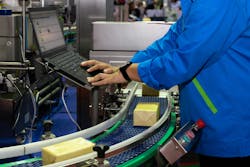In January 2025, before the implementation of Trump’s tariffs, Automation World connected with Robert Schoenberger, editor in chief at Industry Week (an Endeavor Business Media partner publication), to get his perspective on the manufacturing business issues most likely to impact automation decisions in 2025. The full discussion can be accessed in this Automation World Gets Your Questions Answered podcast episode.
According to Schoenberger, the biggest factor is going to be industry’s ongoing workforce issues.
“There's so much competition for a small pool of available employees right now,” he said. “You have the Baby Boomers retiring in large numbers every day and the generations behind them are just not large enough. There are not enough people to replace all of those highly skilled, experienced workers. This has become a crisis for just about every manufacturer out there right now, and automation is helping to fill that gap.”
The collaborative robot (cobot) trend has been proving itself to be increasingly important way for manufacturers to address this.
“They’re less expensive and easier to install,” said Schoenberger when speaking about cobot use in industry. And you're seeing these cobots become more available via robots-a- service (RaaS) models “which helps make them more cost effective for smaller and mid-sized manufacturers.”
The automotive industry’s impact on supply chain roboticization
Highlighting an interesting aspect of the roboticization of industry, Schoenberger said that, if you look at who's spending on robots and automation now, you’ll see that the automotive industry is spending less every year on robotics and installed automation systems.
“You could see this as an indication that they're pulling back on automation,” he said, “but it's a more complex story than that.”
He explained that the automotive industry has been the largest user of automation systems — by a huge margin — for decades now. “They've made these investments over a very long period of time and now they have highly automated facilities,” he said. “So, there's not a lot of room to grow [with automation]. The automotive market's more of a replacement market now for a lot of automation technologies.”
Coupled with this is the automotive industry trend to outsource as much as possible to the supply chain. Schoenberger said this move has been driving “a very strong increase in installations of robotics at metal and machinery companies. The people who are making parts for the automakers are buying a lot of the robots that the Fords, GMs and Toyotas of the world would have been buying a few years ago. It's just moving down the chain and one of the reasons for this is the lower cost [of robots]. You can get a six-axis Fanuc or ABB robot for a tenth of the price that you could have a decade ago.”
How cobots are reducing the need for specific industrial skills
Coming back around to the workforce issue, Schoenberger noted that this is driving interest in cobots because finding a skilled robotics engineer has become very difficult. Cobot programming makes it easier for someone to guide the robot through its required motions and use simplified programming to complete the implementation. “It's a lot easier to set things up now than it used to be, and you don't necessarily need a highly trained engineer for every project,” he added.
Schoenberger added that he’s increasingly seeing cobots used in end-of-line applications for palletizing and packaging. “You don't need complex robotics and programming skills to program a robot for tasks like these,” he said. “But these applications are the sort of thing that helps manufacturers who need one more person in the warehouse for a job that’s very tough to fill right now.”
The impact of housing on the industrial automation investment outlook
Noting his “fairly optimistic” outlook for manufacturing technology investments in 2025, Schoenberger said major industry players have been in a “weird limbo spot for the past 18 months or so. It's just the worst possible scenario for big investments in technology because orders were coming in at a fine pace.”
In other words, manufacturing order levels have clearly not been particularly exciting lately, but they haven’t been so bad that it created a sense that things are awful and manufacturers would need to lay off half of their workers and cut costs to survive. At the same time, orders haven’t been at a level where manufacturers worried about not being able to meet demand and thus feel the need to invest dramatically in technologies to help meet those orders.
When orders are “coming in fine, fine is not a good place to be if you're trying to justify big capital expenses,” explained Schoenberger. “And that really defined almost all of 2024 and the latter half of 2023. You just saw manufacturers waiting it out.”
Schoenberger expects this to change in 2025 largely due to the increase in housing starts. “Any increase in housing starts will ripple through the economy into every manufacturing trend,” he said. “A new house needs a new dishwasher and a new refrigerator. New housing construction means you need more pickups as more contractors drive to the site to build the house and install all the equipment. The more houses you build, the more economic activity that really floods the manufacturing sector.”
Ease of installation and a fast ROI
Though Schoenberger doesn’t expect any one automation technology area to become passé in the near term, he does see more attention focused on automation that’s easier to install and brings a faster ROI (return on investment), such as smaller robots and cobots.
“That's what manufacturers are going to want — something they quickly see a return on,” he said. “Bigger projects where an entire line is pulled out and redesigned from scratch to deliver the best possible, highly orchestrated facility, I don't see that as popular these days. That was always a big automotive initiative anyway. Especially back in the day when they could sell a half a million Toyota Camrys a year. Now that the market is so stratified and everyone wants a slightly different vehicle, you don't see one product dominating the market enough to justify this rather than focusing on simpler robots that do just do one or two things. Everything has to be more flexible. It’s no longer about initiatives to feed top line production as fast as possible like we saw a few years ago.”
This trend isn’t just impacting industries like automotive. The food and beverage industry is also confronting this need for flexibility.
As a case in point, Schoenberger referenced a visit to the Miller Brewing facility in Milwaukee in 2024.
“It's fascinating because you think they're just making Miller beer here. But they’re making 50 different brands of beer — and the packaging and the sizes of the cans are different depending on which line they’re on. It’s a highly automated facility that’s also very flexible because it's not making one thing; it's making numerous different products on the same lines very, very quickly.”
Workforce automation strategies for manufacturers
Speaking about how automation technologies may influence manufacturing workforce strategies around issues such as reskilling programs or training and support for changes in job roles, Schoenberger said the focus he’s seeing now is on strategic one-to-one replacements. He said this is not so much about replacing workers but in figuring out how to “maximize the people a manufacturer can find [to work in industry] and then use technology to fill gaps.”
He pointed to a comment he heard a few years back about the key to manufacturers being able to attract more workers. “They said the first companies that really figure out how to convince a fry cook to come over and work in a manufacturing plant are going to be the ones that have the workforce of the future,” Schoenberger said. “Restaurants have typically hired unskilled labor and trained them to do what they needed. But restaurant work is tough, with long hours and working nights and weekends. However, a manufacturing plant can offer workers a more predictable nine-to-five or seven-to-three job shift. In manufacturing, employees have a lot more predictability in their work and there's the opportunity for overtime. So, there are a lot of advantages manufacturers can offer, but the manufacturing industry has always struggled to find the people that food service has been able to grab.”
Another significant issue for manufacturers is on the planning side, as companies look to boost productivity by, say, 10%. How can they do best do that given workforce and tech spending constraints? Schoenberger said that if manufacturers can’t hire 10% more people, they should look at hiring 5% more people and assess which lines have the least value add to determine where a simplified automation system could help them move people to more valuable operations.
He noted this need is particularly important in maintenance.
“Maintenance engineers are worth their weight in gold these days,” Schoenberger said. “Because it is really tough to find someone who can come in, understand these machines and make sure they are doing everything they can [to ensure operations stay up and running]. That's why we're seeing increased spending on predictive maintenance systems but also on sensors that can be attached to various pieces of equipment to report back on vibration and temperature to help manufacturers understand when a bearing is going bad so that it can be replaced before the line goes down. There’s a huge interest in this even though it can be hard to account for, because how do you prove that you saved money if the machine didn't explode. Despite this, were seeing good numbers coming out of companies that are focusing on doing this.”
Other Automation World content covering the intersection of manufacturing business factors and tech spending:
Leaders relevant to this article:



